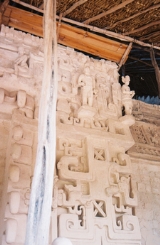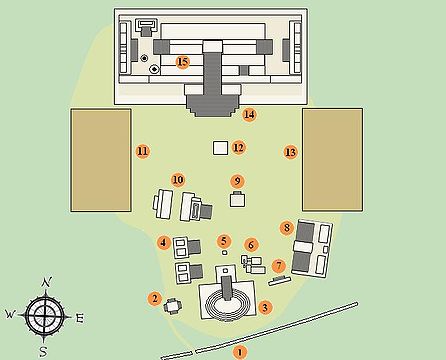
Ek' Balam
Encyclopedia
Ek' Balam is a pre-Columbian
archaeological site
in municipality of Temozón in Yucatán
, Mexico
. These building were constructed by the Maya civilization
. The site is located 30 km north of Valladolid
, 2 km away from a small Maya village
by the same name. In Yucatec Mayan the name means "Black Jaguar". In ancient times, it was a large city, controlling a populous and prosperous countryside. Its impressive architecture dates, for the most part, to the Late Classic.

1. Defensive Walls
2. Entrance Arch
3. Oval Palace
4. The "Twin Pyamids" are atop one platform at the southwest corner of the site and have steps to each.
5. Chapel
6. Stelae which depicts a ruler of Ek Balam, probably Ukit Jol Ahkul
7. Structure 12
8. Structure 10
9. Structure 7
10. Ballcourt
11. Structure 2 on the West corner of the Acropolis is as yet unexcavated and is the 2nd largest building on the site.
12. Steam Bath
13. Structure 3 on the East corner of the Acropolis is, like Structure 2, unexcavated and is the 3rd largest building on the site.
14. The Acropolis on the North side of the site is the largest structure at Ek' Balam and contains the tomb of Ukit Kan Le'k Tok'. It measures 146 meters across, 55 meters wide and 29 meters tall.
15. Tomb of Ukit Kan Le'k Tok'.
featuring winged Mayan warriors, as well as inscriptions in the Maya script
. From the top of this structure can be seen the pre-Columbian sites of Coba
and Chichen Itza
.
Pre-Columbian
The pre-Columbian era incorporates all period subdivisions in the history and prehistory of the Americas before the appearance of significant European influences on the American continents, spanning the time of the original settlement in the Upper Paleolithic period to European colonization during...
archaeological site
Archaeological site
An archaeological site is a place in which evidence of past activity is preserved , and which has been, or may be, investigated using the discipline of archaeology and represents a part of the archaeological record.Beyond this, the definition and geographical extent of a 'site' can vary widely,...
in municipality of Temozón in Yucatán
Yucatán
Yucatán officially Estado Libre y Soberano de Yucatán is one of the 31 states which, with the Federal District, comprise the 32 Federal Entities of Mexico. It is divided in 106 municipalities and its capital city is Mérida....
, Mexico
Mexico
The United Mexican States , commonly known as Mexico , is a federal constitutional republic in North America. It is bordered on the north by the United States; on the south and west by the Pacific Ocean; on the southeast by Guatemala, Belize, and the Caribbean Sea; and on the east by the Gulf of...
. These building were constructed by the Maya civilization
Maya civilization
The Maya is a Mesoamerican civilization, noted for the only known fully developed written language of the pre-Columbian Americas, as well as for its art, architecture, and mathematical and astronomical systems. Initially established during the Pre-Classic period The Maya is a Mesoamerican...
. The site is located 30 km north of Valladolid
Valladolid, Yucatán
Valladolid is a small city in Valladolid Municipality in the southeastern part of the Mexican state of Yucatán. Valladolid is in the inland eastern part of the state....
, 2 km away from a small Maya village
Maya peoples
The Maya people constitute a diverse range of the Native American people of southern Mexico and northern Central America. The overarching term "Maya" is a collective designation to include the peoples of the region who share some degree of cultural and linguistic heritage; however, the term...
by the same name. In Yucatec Mayan the name means "Black Jaguar". In ancient times, it was a large city, controlling a populous and prosperous countryside. Its impressive architecture dates, for the most part, to the Late Classic.
Architecture
There are 45 structures, including:
1. Defensive Walls
2. Entrance Arch
3. Oval Palace
4. The "Twin Pyamids" are atop one platform at the southwest corner of the site and have steps to each.
5. Chapel
6. Stelae which depicts a ruler of Ek Balam, probably Ukit Jol Ahkul
7. Structure 12
8. Structure 10
9. Structure 7
10. Ballcourt
Mesoamerican ballgame
The Mesoamerican ballgame or Tlatchtli in Náhuatl was a sport with ritual associations played since 1,000 B.C. by the pre-Columbian peoples of Ancient Mexico and Central America...
11. Structure 2 on the West corner of the Acropolis is as yet unexcavated and is the 2nd largest building on the site.
12. Steam Bath
13. Structure 3 on the East corner of the Acropolis is, like Structure 2, unexcavated and is the 3rd largest building on the site.
14. The Acropolis on the North side of the site is the largest structure at Ek' Balam and contains the tomb of Ukit Kan Le'k Tok'. It measures 146 meters across, 55 meters wide and 29 meters tall.
15. Tomb of Ukit Kan Le'k Tok'.
History
This site dates to the Late Classic period, which ran from roughly 600 to 800 AD. During this period, Mayan civilization flourished and reached its greatest heights.Notable features
The largest structure, known as The Acropolis, has a 5m tall jaguar's mouthJaguars in Mesoamerican culture
The representation of jaguars in Mesoamerican cultures has a long history, with iconographic examples dating back to at least the mid-Formative period of Mesoamerican chronology. The jaguar is an animal with a prominent association and appearance in the cultures and belief systems of pre-Columbian...
featuring winged Mayan warriors, as well as inscriptions in the Maya script
Maya script
The Maya script, also known as Maya glyphs or Maya hieroglyphs, is the writing system of the pre-Columbian Maya civilization of Mesoamerica, presently the only Mesoamerican writing system that has been substantially deciphered...
. From the top of this structure can be seen the pre-Columbian sites of Coba
Coba
Coba is a large ruined city of the Pre-Columbian Maya civilization, located in the state of Quintana Roo, Mexico. It is located about 90 km east of the Maya site of Chichen Itza, about 40 km west of the Caribbean Sea, and 44 km northwest of the site of Tulum, with which it is...
and Chichen Itza
Chichen Itza
Chichen Itza is a large pre-Columbian archaeological site built by the Maya civilization located in the northern center of the Yucatán Peninsula, in the Municipality of Tinúm, Yucatán state, present-day Mexico....
.

